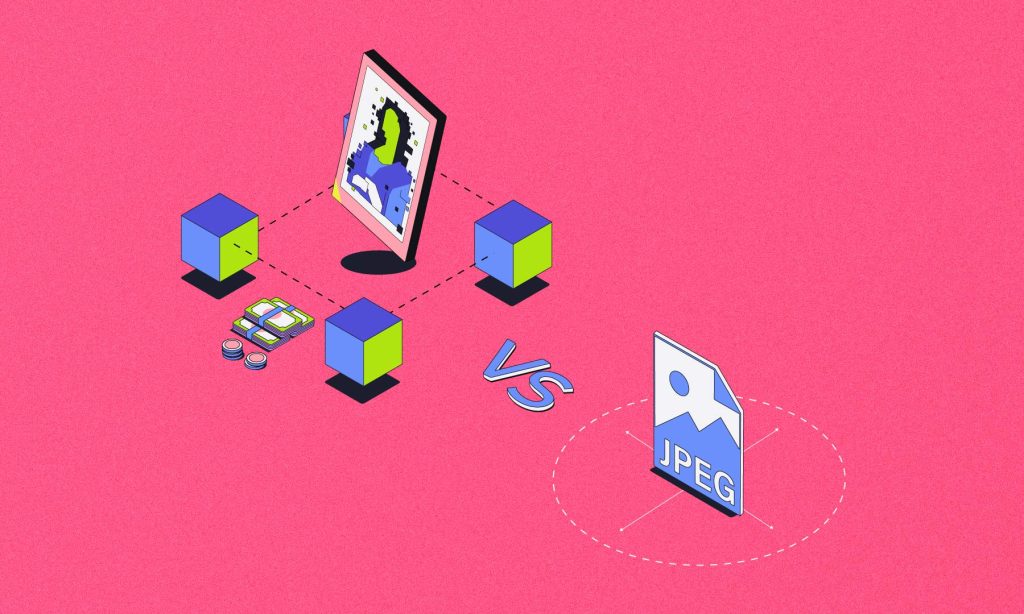We have had digital images and art for a long time now. So what’s so special about NFTs? What’s the craze all about? And can your doodles and digital images be sold for a cool six-figure? Find the answers to all of that and more as we discuss the difference between NFTs and our good ol’ JPEGs. So keep reading!
What are NFTs?
Non-Fungible Tokens, or NFTs, are digital assets stored on the blockchain. Unlike crypto tokens, like Bitcoin, which are fungible (meaning each unit has the same value as any other unit), NFTs are one-of-a-kind. That means they are unique and cannot be exchanged for another identical item because there is no identical item.
NFTs can represent anything valuable, including digital art, music, videos, and tweets. That includes JPEGs of images. Because they are represented and stored on the blockchain, their authenticity is verifiable. And they cannot be duplicated or tampered with. NFTs are bought and sold on blockchain marketplaces. Their value is determined by market demand, just like any other asset.
NFTs have also opened up new possibilities for artists and creators. It allows them to safely store digital copies of their work and monetize it digitally. Read more about them here.
NFT features
NFTs have several features that distinguish them from other digital assets. They are unique, verifiable, and can be traced to their original owner. Besides, they are scarce, transferrable, programmable, and interoperable across blockchain platforms. All of that makes them easier to monetize. They, therefore, serve as collectible items.
Smart contracts: The basis of the difference between NFTs and JPEGs
NFTs are not the same as JPEGs due to smart contracts. Each NFT is created using a specific smart contract. Smart contracts are programs that self-execute when a certain set of criteria is met. The NFTs use these contracts to define their unique characteristics, including ownership, attributes, and other details.
There are many different types of NFT contracts, each with its features. Some have functionalities for gaming or other use cases, while others may focus on simplicity or ease of use. Here are four common types of NFT contracts:
- ERC-721 is the most widely used standard for NFTs. It defines a set of rules for creating and managing unique/non-fungible tokens on the Ethereum blockchain.
- ERC-1155 contract standard allows for creating fungible and non-fungible tokens on Ethereum. A multi-token standard, it is popular for creating game items and other digital collectibles.
- TRC-721 standard is similar to ERC-721 but is used on the TRON blockchain.
- BEP-721 is the NFT contract standard used on the Binance Smart Chain.
The main differences between these contracts are their features, capabilities, and the blockchain platform they are built on.
Is an NFT a JPEG?
The simple answer is no. An NFT (non-fungible token) is not just a JPEG or digital file. It is more than that because it verifies can ownership of the underlying asset. Something that JPEGs do not allow.
JPEGs, however, can be minted as NFTs via marketplaces like OpenSea or Rarible. So yes, you can dream of selling that .jpeg file of your doodle for a million bucks.
That’s the broad difference between them. Read on for more details.
The difference between NFTs and JPEGs
JPEG files are digital image files that can be duplicated and shared freely. So it is hard to establish ownership with them. NFTs, on the other hand, are unique digital assets. So they represent ownership of a particular asset and can have significant value.
NFTs can represent art, music, or other digital content.
Also, because JPEG files can be easily duplicated, verifying the authenticity of an original image can be difficult. NFTs are stored on a blockchain and are, therefore, verifiable.
JPEG files can be used for various purposes, from personal photos to professional graphic design work. NFTs, on the other hand, are typically used for unique digital content that can be monetized.
Why are NFTs expensive?
Since NFTs are scarce collectible items, they tend to get expensive. So expensive that auction houses have started throwing NFTs under the hammer.
Also, many NFTs are created by well-known artists, musicians, or other celebrities, which increases their perceived value and makes them more expensive. Similarly, NFTs associated with popular franchises, games, or other media can be highly sought after and command high prices.
Additionally, the platform’s reputation, where an NFT is minted and sold, can influence its price due to higher demand. Established marketplaces with a good reputation may attract more buyers and sellers.
Conclusion
Although we hate to add disclaimers, you must keep in mind that the value of an NFT largely depends on market demand. So it is essential to research the NFT market well before you create an NFT artwork.
FAQs
How are NFTs different from JPEGs?
NFTs (Non-Fungible Tokens) and JPEGs are fundamentally different. NFTs represent unique ownership of digital assets, like art or music, stored on the blockchain, while JPEGs are simple image files without any ownership or verification mechanism.
Can a JPG be an NFT?
Yes, a JPG can be turned into an NFT. NFTs represent ownership of digital assets, and by creating an NFT for a JPG, you can establish unique ownership and provenance for that specific image on the blockchain.
Should NFT be JPEG or PNG?
NFTs can be associated with various file formats, including JPEG or PNG. The choice of format depends on the type of digital asset. JPEG is more common for images, while PNG is preferred for images with transparent backgrounds or higher quality.








